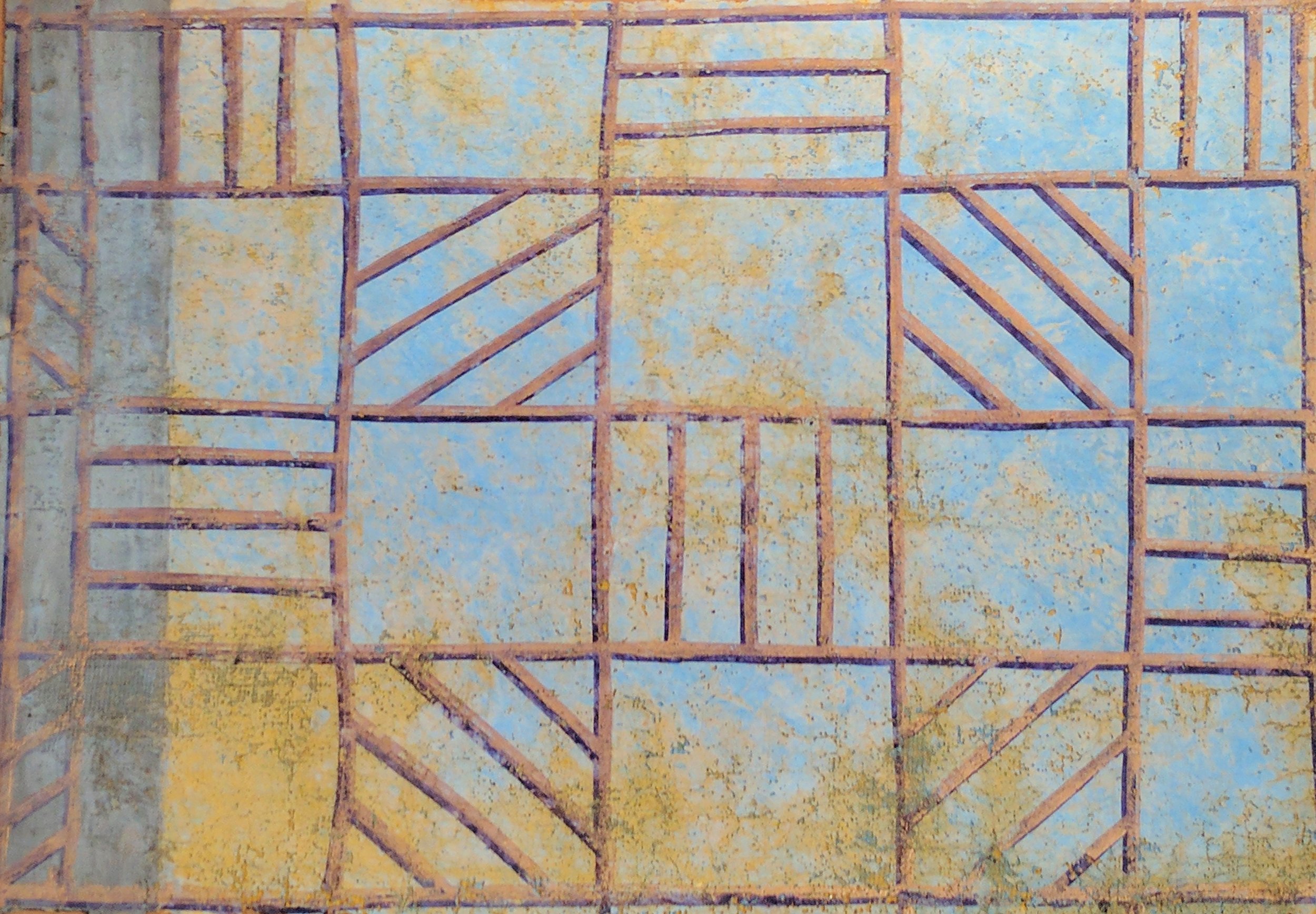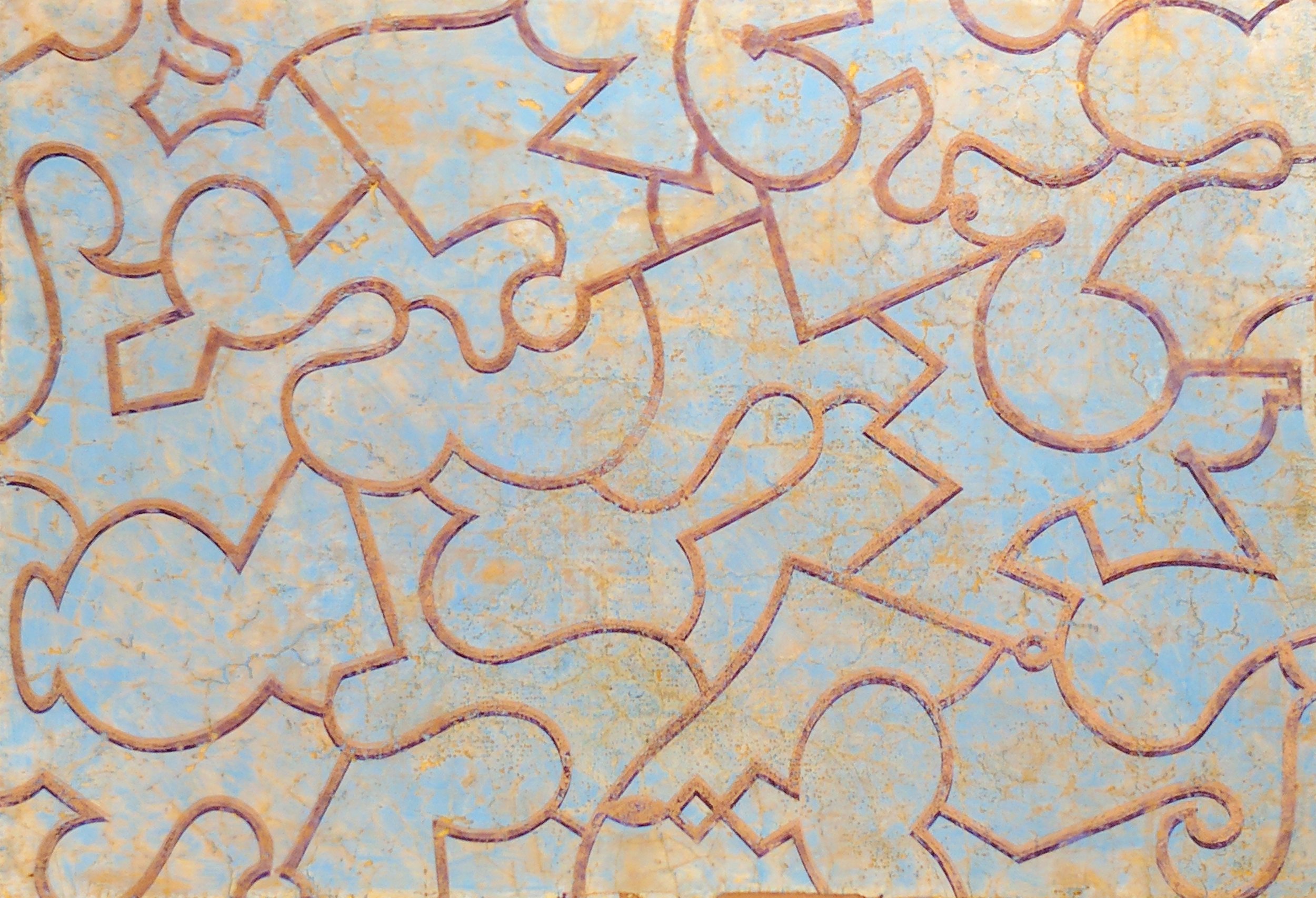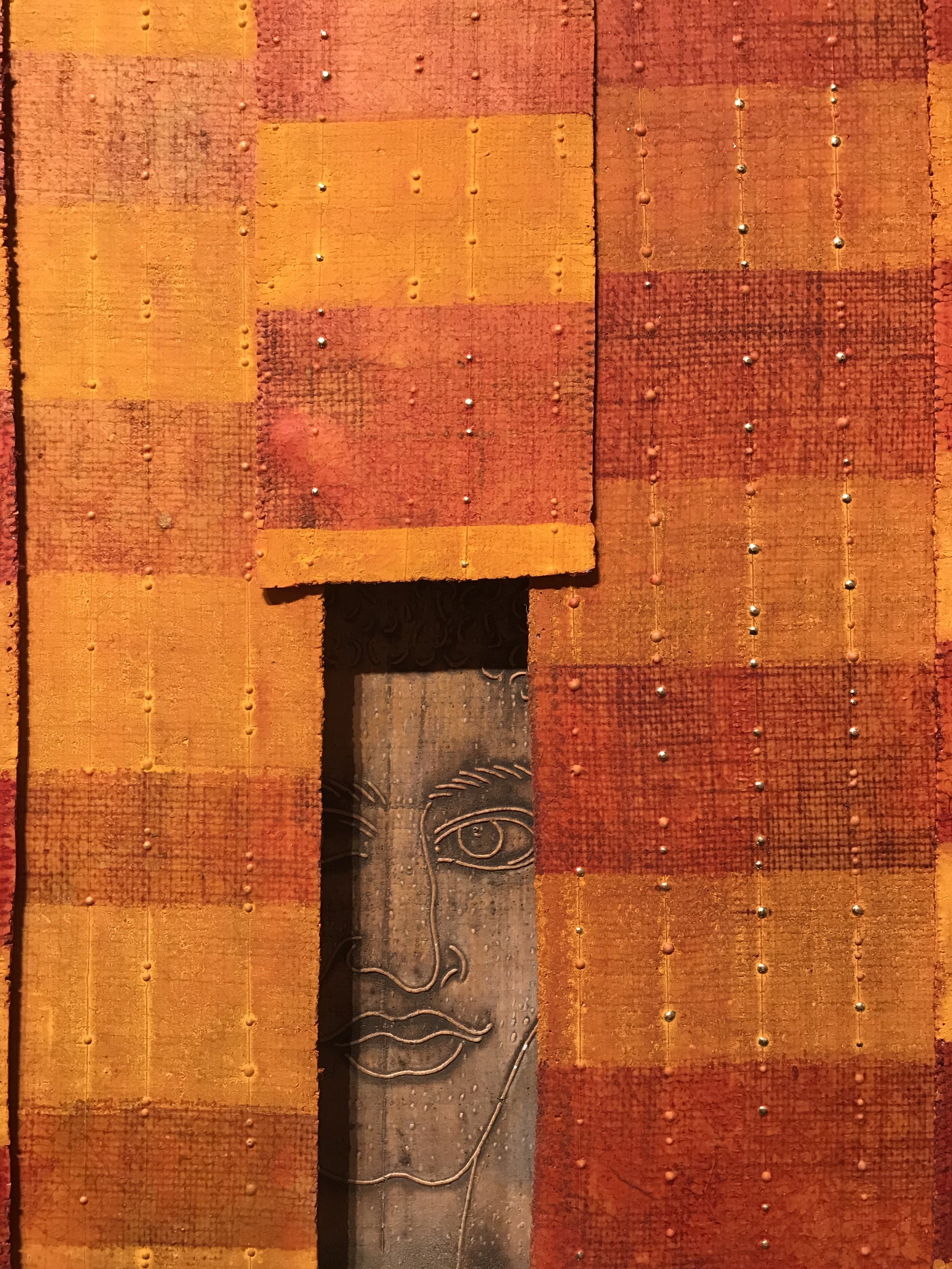From The Collection: George Mason
George Mason, Untitled, encaustic on plaster, 20” x 25”, 2010
George Mason has a background in ceramic architectural tile and his work is steeped in the exploration of materials and history. Richly textured and saturated with color, the largest of his “relief tapestries” are pieced together panels that occupy entire walls.
Mason began to combine encaustics with layered paper cut outs while teaching in Jerusalem, Indonesia, and India. Eventually, these works led to a multi faceted question that challenged him to synthesize several divergent interests. He asked, “Is it possible to create large dimensional works, outside the frame, highly textural, referencing textile, ceramic, and cut out traditions, that hang with authority yet surrender to gravity with grace?
The recipient of three National Endowment for the Arts awards, and a founder of Watershed Center for Ceramic Arts, Mason has taught at Cranbrook Academy of Art, the College of Ceramics at Alfred University, Ohio State, U.C. Boulder, and Haystack. In his home state of Maine, he has shown at the Portland Museum of Art, the Center for Maine Contemporary Art, The Farnsworth Museum, and Bowdoin College Museum of Art. Mason completed over thirty Percent For Art architectural ceramic projects for schools in Maine and New York City between 1986 and 2003, including a commission for The Federal Reserve Bank in Atlanta, Georgia. R&F is thrilled to have two pieces by George as part of our permanent collection.
Can you tell us about your work in R&F’s Permanent Collection?
I made these two pieces many years ago when I was coming out to R&F in Kingston, and working in the studio for a week at a time. Using Hydrocal plaster with yellow ochre pigment, I made very thin plaster panels on burlap, and then crackled them to re-establish their suppleness as textiles.
George Mason, Heavenly Pivot, encaustic on plaster, 18” x 24.5”, 2010
I began to heat the panels and apply encaustic. I then combined my separate encaustic paper cutout experiments and placed them on the plaster panels to heat and create transfer prints. I first applied cerulean blue to the plaster then printed with the cutout using a violet encaustic. I printed a second time with a duplicate cutout using a gold encaustic but offsetting the register slightly.
At the time I was looking at the frescoes of Giotto and I was swept away by how he rendered the sky. I wanted to create a kind of celestial gate with deep space beyond. That came to feel like a permeable membrane at the edge of the great beyond with its inherent relationship to mortality. I didn’t anticipate that. As ever, I make in order to come to know what I am making, and to tap into the larger mystery that connects us all.
Seeing pictures of the two R&F pieces reminded me of the thread of an inquiry that I had all but forgotten. Shortly after I made them I changed plasters to one that required less water to go into solution. I found I was no longer getting the sharp edges that I had formally achieved when printing my cutouts on plaster, and I just lost interest in the method. I see now that the problem was the harder surface being less porous and not grabbing and absorbing the encaustic from the cut out. I will definitely try that more porous plaster again with new encaustic cutouts.
George Mason, Untitled with Portal, Hydrocal plaster, burlap, casein paint, and encaustic, 20.75” x 64.50", 2020
Did you develop this method yourself?
Egyptians were using plaster and burlap 4,000 years ago, and the ancient world employed casein paint and encaustic with great skill. Nothing new there. But honestly, I came to my particular method of working out of a desire to free my work from the constraints of the kiln shelf.
While traveling overseas, seeking out ruins and traces of the long forgotten, I took paper and blade to capture the exotic and the mundane. I carried these thin sculptures in my backpack. I fell in love with textiles and their place in local domestic ritual. In time and with lots of experiments, I began to combine all these various threads.
“I used to create unexpected obstacles that audience was required to navigate, but in this Covid time I am at the door welcoming, simply grateful that someone takes some notice.”
Can you explain how you believe art and visual inquiry can be a relational vehicle that builds community and honors place?
At that time I was interested in presenting my work in unexpected locations, such as a sod roof stone building high on a blueberry barren with a jaw-dropping view of the Penobscot Bay that took twenty five minutes to ascend.
George Mason, Untitled with Spire on Muted Violet, Hydrocal plaster, burlap, casein paint, and encaustic, 20.75” x 40", 2020
My question was whether the experience of the work would be qualitatively different when audience stumbled upon it, without anticipation or expectation. They would be free to navigate the ‘not knowing’ without familiar prompts that confirmed that what they were seeing was art and therefore somehow worthy of their attention. For those who knew the work was there, they had to choose to make the effort.
It did change the experience. Many didn’t know what they were looking at, but were surprised and delighted nonetheless. They didn’t need to call it art to have a meaningful interaction.
I used to create unexpected obstacles that audience was required to navigate, but in this Covid time I am at the door welcoming, simply grateful that someone takes some notice.
George Mason, Unspoken, Hydrocal plaster, burlap, casein paint, and encaustic, 27” x 87”, 2020
How did you come to teach overseas?
I was asked to teach at Bezalel Academy of Art in Jerusalem after two faculty visited the College of Ceramics at Alfred in upstate New York, where I was teaching. They saw a room full of glaze tests from my class. The emphasis was making glaze as though cooking in a kitchen, with a little of this and a little of that. At the time glaze formulation was quite daunting and approached as a science on the molecular level. Many art students found that just too formal and forbidding.
I also taught on the island of Java, Indonesia at two universities. I was asked by the United States Information Agency to introduce and teach porcelain classes. This unlikely invitation happened because a year prior I had been in Bali and happened onto a wedding where I met an American who worked at the US Embassy. A Smithsonian show called American Porcelain was touring in Indonesia and he was in charge of installing it and a number of the pieces needed repair. As fate would have it, I was in that show. When I shared that information he asked me to come to the embassy in Jakarta when I returned to Java to help him fix the damaged work. My going back to Indonesia to teach at his behest a year later was serendipity pure and simple.
George Mason, Untitled with Cadmium Orange, Hydrocal plaster, burlap, casein paint, and encaustic, 20.75” x 65.50", 2020
Having met Krishnamurti in India long before, I wanted to visit the Krishnamurti Schools to see how the learning principles set forth by this thought leader and giant of the 20th century were implemented. These schools were alternative in that they had reflective components built into the schedule of the day. But the normal pressures to perform well on exams and get into the best universities were also very much in evidence. I offered classes in studio art and acupuncture five element theory with my wife Susan.
George Mason, Red, Hydrocal plaster, burlap, casein paint, encaustic, 20.75” x 94”, 2021
“I have held that making is prayer and that naming the activity as art does not fully capture the affection and reciprocity. To participate is the blessing.”
How have you understood your Art up until recent experiments with recognizable content?
My work has relied on color, texture, light, shadow, and gravity.
I have held that red is no metaphor but a force independent of reference. I have held that my works are fugitive and cannot be approached directly; that they nourish without telling a story; and that a viewer is rewarded by a receptive attentiveness, not an aggressive determination. (So, for example, if I want to see the northern lights I must first include the night sky in my ongoing rhythm of attention, and be patient.)
I have held that making is prayer and that naming the activity as art does not fully capture the affection and reciprocity. To participate is the blessing.
I have held that the art encounter is not dependent on memory, and the recollection of that encounter is not related in any consequential way to the original experience. Memory recapitulates a very different story by positing the sensation of owning a mental object made safe and manageable. This narrative, living as memory can be rendered again and again. But revelation can never be brought back. We are only left with the ash of description.
George Mason, Empire, Hydrocal plaster, burlap, casein paint, encaustic, 20.75” x 53.50", 2020
How has Covid impacted your art?
These last two years have changed most every aspect of how I interact with people, and that has affected my studio practice. Over time the heaviness of both the political climate and the loss of opportunities to be neighborly have weighed on me. My work just sat on the walls in a kind of limbo with no eyes on it. My interest flagged and the inquiry stalled.
During this time my artist friend Sondra Bogdonoff and I decided to check in with each other every two weeks over Zoom. That made all the difference in the studio. Having another witness helped me feel held within a circle of meaning, and accountable to someone. My long-standing complaint about the ‘art scene’ had to confront the irony of its absence. I came to acknowledge my great debt to the world of the arts for encouraging audience to play their essential role in the overall arc of my studio process.
Covid has made clear to me just how important a witness is to my remaining engaged, to my processing what I have done, and ultimately, to my moving on.
Did your work change during this time?
Yes. I started experimenting with recognizable content for the first time; wrestling with how my work might participate in the racial equity dialogue that was and is pulsing with such urgency. I questioned whether my comfort with abstraction was complicit in sidestepping that reckoning.
George Mason, Unspoken (detail)
The faces in my new work were intended to confront and be the haunting presence of black and indigenous Americans that live within us, overlooked, and hidden from view. They were intended to demand our attention and be a reminder of how we have turned away. Yet they are not angry as I anticipated; or shaming, or confrontational. Whoever they are, they are the guests I have ignored.
Can you say more about your relationship to audience?
Providing a roadmap to navigate a work of art is one way to be a thoughtful host, even though it may prompt a certain narrow response. I am paying particular attention to my relationship with audience at this time and being more forthcoming about the peculiar logic and discipline forged in my studio over many years. I am always having to confront the question, ‘Am I interested enough in audience participation to expend the kind of effort required to include them? Are they valued or begrudgingly accommodated?’
And as a frequent audience member myself, I never presume to know what I am looking at. I am obliged to approach the art respectfully, tentatively, even reverently; with an open heart, not a conclusive mind.
To see more of George Mason’s work, visit georgemasonart.com.









